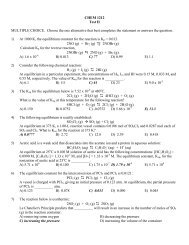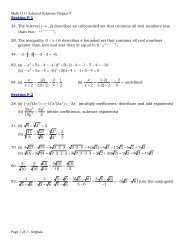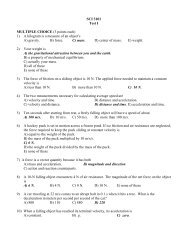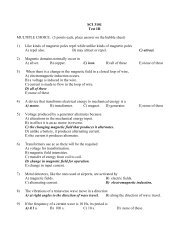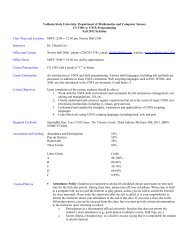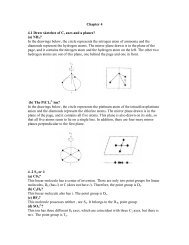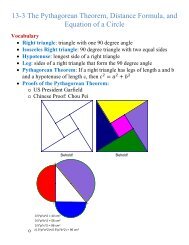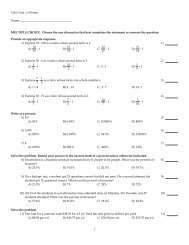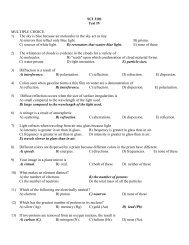Chapter 6 6.6 Write the Nernst equation for? - Valdosta State ...
Chapter 6 6.6 Write the Nernst equation for? - Valdosta State ...
Chapter 6 6.6 Write the Nernst equation for? - Valdosta State ...
You also want an ePaper? Increase the reach of your titles
YUMPU automatically turns print PDFs into web optimized ePapers that Google loves.
<strong>Chapter</strong> 6<strong>6.6</strong> <strong>Write</strong> <strong>the</strong> <strong>Nernst</strong> <strong>equation</strong> <strong>for</strong>?(a) The reduction of 0 2 ?In general terms, <strong>the</strong> <strong>Nernst</strong> <strong>equation</strong> is given by <strong>the</strong> <strong>for</strong>mula:o ⎛ RT ⎞E = E − ⎜ ⎟ln Q⎝ NF ⎠where Q is <strong>the</strong> reaction quotient. For <strong>the</strong> reduction of oxygen:O 2 (g) + 4 H + (aq) + 4 e- à 2 H 2 O(1)Q =pOE = Eo21[H+]4⎛ 0.059V− ⎜⎝ 2⎞ ⎛⎟log⎜⎠ ⎝ pO21[H+]4⎞⎟⎠There<strong>for</strong>e, <strong>the</strong> potential <strong>for</strong> O 2 reduction at pH = 7 and p(O 2 ) = 0.20 bar isE = 1.229 V - 0.42 = 0.81 V(b) The reduction of Fe 2 O 3 (s)?For <strong>the</strong> reduction of solid iron(III) oxide:Fe 2 O 3 (s) + 6 H + (aq) + 6 e - à 2 Fe(s) + 3 H 2 O(l)1Q =+ 6[ H ]E = Eo⎛ 0.059V⎞ ⎛ 1− ⎜ ⎟log⎜+⎝ 6 ⎠ ⎝[H ]since pH = -log[H + ] = -2.3ln[H + ] and log[H + ] 6 = 6log[H + ].Q1[ H ]=+ 6E = Eo⎛ 0.059V⎞− ⎜ ⎟13.8(pH )⎝ 6 ⎠6⎞⎟⎠
6.8 Using Frost diagrams?(a) What happens when Cl 2 is dissolved in aqueous basic solution?The Frost diagram <strong>for</strong> chlorine in basic solution is shown in Figure 6.16 and isreproduced below.If <strong>the</strong> points <strong>for</strong> Cl - and ClO 4 - are connected by a straight line, Cl 2 lies above it.There<strong>for</strong>e, Cl 2 is <strong>the</strong>rmodynamically susceptible to disproportionation to Cl - and C1O 4-when it is dissolved in aqueous base. In practice, <strong>the</strong> oxidation of ClO - is slow, so asolution of Cl - and ClO - is <strong>for</strong>med when Cl 2 is dissolved in aqueous base.(b) What happens when Cl 2 is dissolved in aqueous acid solution?The Frost diagram <strong>for</strong> chlorine in acidic solution is shown in Figure 6.16. If <strong>the</strong> points <strong>for</strong>C1 - and any positive oxidation state of chlorine are connected by a straight line, <strong>the</strong> point<strong>for</strong> Cl 2 lies below it (if only slightly). There<strong>for</strong>e, Cl 2 will not disproportionate. However,E° <strong>for</strong> <strong>the</strong> C1 2 /C1 - couple, 1.36 V, is more positive than E° <strong>for</strong> <strong>the</strong> O 2 /H 2 O couple, 1.23V.There<strong>for</strong>e, Cl 2 is <strong>the</strong>rmodynamically capable of oxidizing water as follows, although <strong>the</strong>reaction is very slow:C1 2 (aq) + H 2 O(l) à 2C1(aq) + 2H + (aq) + 1/2 O 2 (1)E° = 0.13 V(c) Should HClO 3 disproportionate in aqueous acid solution?The point <strong>for</strong> C1O 3 - in acidic solution on <strong>the</strong> Frost diagram in Figure 6.16 lies above <strong>the</strong>single straight line connecting <strong>the</strong> points <strong>for</strong> Cl 2 and ClO 4 - . There<strong>for</strong>e, since C1O 3 - is<strong>the</strong>rmodynamically unstable with respect to disproportionation in acidic solution (i.e. itshould disproportionate), <strong>the</strong> failure of it to exhibit any observable disproportionationmust be due to a kinetic barrier.
6.9 <strong>Write</strong> <strong>equation</strong>s <strong>for</strong> <strong>the</strong> following reactions:(a) N 2 0 is bubbled into aqueous NaOH solution?Part of <strong>the</strong> Frost diagram <strong>for</strong> nitrogen in basic solution is shown below (<strong>the</strong> entirediagram is shown in Figure 6.9Inspection of it shows that N 2 O lies above <strong>the</strong> line connecting N 2 and NO 3 - . There<strong>for</strong>e,N 2 O is <strong>the</strong>rmodynamically susceptible to disproportionation to N 2 and NO 3 - in basicsolution:5 NO(aq) + 2 OH - (aq) à 2 N0 3 - (aq) + 4 N 2 (g) + H 2 O(l)However, <strong>the</strong> redox reactions of nitrogen oxides and oxyanions are generally slow. Inpractice, N 2 O has been found to be inert.(b) Zinc metal is added to aqueous acidic sodium triiodide?The overall reaction is:Zn(s) + I 3 - (aq) à Zn 2+ (aq) + 3 I - (aq)Since E° values <strong>for</strong> <strong>the</strong> Zn 2+ /Zn and I 3 - /I - couples are -0.76 V and 0.54 V, respectively(<strong>the</strong>se potentials are given in Appendix 2), E° <strong>for</strong> <strong>the</strong> net reaction above is:0.54 V + 0.76 V = 1.30 V.Since <strong>the</strong> net potential is positive, this is a favorable reaction, and it should be kineticallyfacile if <strong>the</strong> zinc metal is finely divided and thus well exposed to <strong>the</strong> solution.
(c) I 2 is added to excess aqueous acidic HC1O 3 ?Since E° values <strong>for</strong> <strong>the</strong> I 2 and ClO 3 - /C1O 4 - couples are 0.54 V and -1.20 V, respectively(see Appendix 2), <strong>the</strong> net reaction involving <strong>the</strong> reduction of I 2 to I - and <strong>the</strong> oxidation ofC1O 3 - to ClO 4 - will have a net negative potential:E° = 0.54 V + (-1.20 V) = -0.66 V.There<strong>for</strong>e, this net reaction will not occur. However, since E° values <strong>for</strong> <strong>the</strong> IO - 3 /I 2 andC1O - 3 /Cl - couples are 1.19 V and 1.47 V, respectively, <strong>the</strong> following net reaction willoccur, with a net E° = 0.28 V:half-reaction: ClO - 3 (aq) + 6 H + (aq) + 6 e - à C1 - (aq) + 3 H 2 O(l)half-reaction: I 2 (s) + 6 H 2 O(l) à 2IO - 3 (aq) + 12H + (aq) + 10e -net rxn: 3I 2 (s) + 5 ClO - 3 (aq) + 3 H 2 0(l) à 6 IO - 3 (aq) + 5 Cl - (aq) + 6 H + (aq)6.10 Will acid or base most favor <strong>the</strong> following half-reactions?(a) Mn 2+ à Mn0 4 - ?You can answer questions such as this by applying Le Chatelier’s principle to <strong>the</strong>complete, balanced half-reaction, which in this case is:Mn 2+ (aq) + 4 H 2 O(l) à Mn0 4 - (aq) + 8 H + (aq) + 5 e -Since hydrogen ions are produced by this oxidation half-reaction, raising <strong>the</strong> pH willfavor <strong>the</strong> reaction. (Alternatively, you could come to <strong>the</strong> same conclusion by using <strong>the</strong><strong>Nernst</strong> <strong>equation</strong>.) Thus, this reaction is favored in basic solution. At a sufficiently highpH, Mn2 will precipitate as Mn(OH) 2 . The rate of oxidation <strong>for</strong> this solid will be slowerthan <strong>for</strong> dissolved species.(b) ClO 4 - à ClO 3 - ?The balanced half-reaction is:ClO 4 - (aq) + 2 H + (aq) + 2 e - à ClO 3 - (aq) + H 2 O(l)Since hydrogen ions are consumed by this reduction half-reaction, lowering <strong>the</strong> pH willfavor <strong>the</strong> reaction. Thus, this reaction is favored in acidic solution. This is <strong>the</strong> reason thatperchioric acid is a dangerous oxidizing agent, even though salts of <strong>the</strong> perchlorate ionare frequently stable in neutral or basic solution.(c) H 2 O 2 à 0 2 ?The balanced half-reaction is:H 2 O 2 (aq) à O 2 (g) + 2H + (aq) + 2e -Since hydrogen ions are produced by this oxidation half-reaction, raising <strong>the</strong> pH willfavor <strong>the</strong> reaction. Thus, <strong>the</strong> reaction is favored in basic solution. This means thathydrogen peroxide is a better reducing agent in base than in acid.
(d) I 2 à 2I - ?Since protons are nei<strong>the</strong>r consumed nor produced in this reduction half-reaction, andsince I is not protonated in aqueous solution (because HI is a very strong acid), thisreaction has <strong>the</strong> same potential in acidic or basic solution, 0.535 V (this can be confirmedby consulting Appendix 2).6.12 Determine <strong>the</strong> standard potential <strong>for</strong> <strong>the</strong> reduction of ClO 4 - to Cl 2 ?The Latimer diagram <strong>for</strong> chlorine in acidic solution is given in Appendix 2 and <strong>the</strong>relevant portion of it is reproduced below:To determine <strong>the</strong> potential <strong>for</strong> any couple, you must calculate <strong>the</strong> weighted average of <strong>the</strong>potentials of intervening couples. In general terms it is:and in this specific case it is:0 00( n E + n E + ... + n E )11( n + n + ... + n )1((2)(1.201V) + (2)(1.181V) + (2)(1.674V) + (1)(1.674V))( 2 + 2 + 2 + 1)222nnn== 1.392VThus, <strong>the</strong> standard potential <strong>for</strong> <strong>the</strong> ClO 4 - /Cl 2 couple is 1.392 V. The balanced halfreaction<strong>for</strong> this reduction is:2ClO 4 - (aq) + 16H + (aq) + 14e - à Cl 2 (g) + 8H 2 0(l)Note that <strong>the</strong> point <strong>for</strong> ClO 4 - at pH 0 in <strong>the</strong> Frost diagram shown in Figure 6.16 has a yvalue of approximately 9.7, which is NE°/V or 7(1.392).





